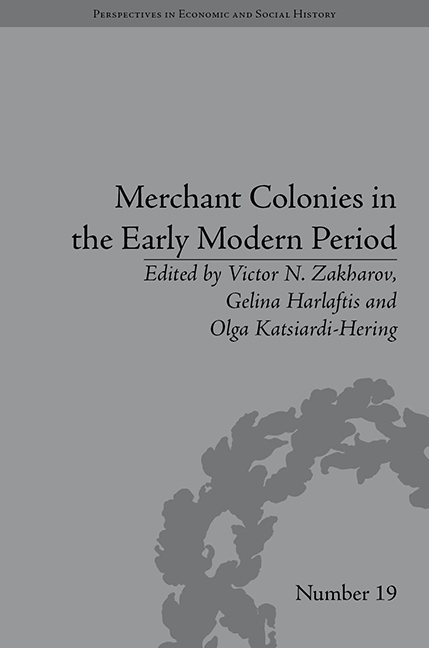Book contents
- Frontmatter
- Contents
- List of Figures and Tables
- List of Contributors
- Introduction
- 1 Early Modern English Merchant Colonies: Contexts and Functions
- 2 German and Italian Merchant Colonies in Early Modern England
- 3 Dynamism and Integration of the North European Merchant Communities in French Ports in the Eighteenth Century
- 4 Opportunity and Legislation: How the Armenians Entered Trade in Three Mediterranean Ports
- 5 Russian Merchant Colonies in Seventeenth-Century Sweden
- 6 Foreign Merchant Communities in Eighteenth-Century Russia
- 7 Greek Merchant Colonies in Central and South-Eastern Europe in the Eighteenth and Early Nineteenth Centuries
- 8 Community for Commerce: An Introduction to the Nezhin Greek Brotherhood Focusing on its Establishment as a Formal Institution in the Years Between 1692 and 1710
- 9 Entrepreneurship at the Russian Frontier of International Trade. The Greek Merchant Community/Paroikia of Taganrog in the Sea of Azov, 1780s–1830s
- Notes
- Index
9 - Entrepreneurship at the Russian Frontier of International Trade. The Greek Merchant Community/Paroikia of Taganrog in the Sea of Azov, 1780s–1830s
- Frontmatter
- Contents
- List of Figures and Tables
- List of Contributors
- Introduction
- 1 Early Modern English Merchant Colonies: Contexts and Functions
- 2 German and Italian Merchant Colonies in Early Modern England
- 3 Dynamism and Integration of the North European Merchant Communities in French Ports in the Eighteenth Century
- 4 Opportunity and Legislation: How the Armenians Entered Trade in Three Mediterranean Ports
- 5 Russian Merchant Colonies in Seventeenth-Century Sweden
- 6 Foreign Merchant Communities in Eighteenth-Century Russia
- 7 Greek Merchant Colonies in Central and South-Eastern Europe in the Eighteenth and Early Nineteenth Centuries
- 8 Community for Commerce: An Introduction to the Nezhin Greek Brotherhood Focusing on its Establishment as a Formal Institution in the Years Between 1692 and 1710
- 9 Entrepreneurship at the Russian Frontier of International Trade. The Greek Merchant Community/Paroikia of Taganrog in the Sea of Azov, 1780s–1830s
- Notes
- Index
Summary
Taganrog developed as the first city-port in south Russia, part of the strategic plan of the Russian Empire to expand southwards into the Black Sea and the Mediterranean and to create a new economic zone which would later specialize in grain trade. It was the most important port in the Sea of Azov up until the mid-1860s and the second most important of southern Russia after the port of Odessa. It was named after the horn-like shape of the peninsula (tagan) which dominates the small inlet of the north-eastern Sea of Azov. In this remote point for international trade, which developed based on the Russian imperial plans for expansion southwards, the Greeks contributed significantly to the integration of the area into the international economy. During the first half of the nineteenth century the large and affluent Greek merchant community or paroikia of Taganrog was so dominant in the economic and social life of the town to the extent that the Russian novelist Vassili Sleptsov referred to it as a ‘Greek Kingdom’. Greeks brought with them entrepreneurship, in other words capital, technical know-how and their networks in trade and shipping, and promoted the economic development of the area. Despite the fact that the Greek population in Taganrog was smaller than in Odessa it made up a dense ethnic-cultural group which demonstrated dynamism through their economic and social activities.
- Type
- Chapter
- Information
- Merchant Colonies in the Early Modern Period , pp. 157 - 180Publisher: Pickering & ChattoFirst published in: 2014



